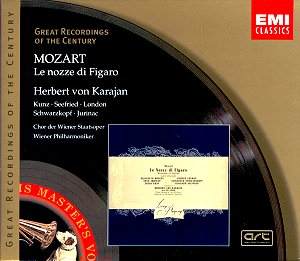There are many points at which one can commence a study
of an opera recording. Some obvious ones are the story on which it is
based, the libretto, and the score. With a recording by von Karajan
in the 1950s where Walter Legge was the producer another point is the
producer's statement about the performance. The notes in the accompanying
booklet are by the distinguished Richard Osborne. In 1998 Osborne’s
Herbert von Karajan: A Life in Music was published. Of this performance
Osborne tells us that Legge insisted on the omission of the secco recitatives.
He opines that such recitatives are "damaging to our larger sense
of Le nozze di Figaro as music theatre" and their absence "throw(s)
into sharp relief Karajan’s fierce brilliant almost symphonic approach".
Here is a taut orchestral performance with Karajan
in firm control. With one or two exceptions when the orchestra threatens
to overwhelm the singers, the tight rein provides an orchestra supporting
them and enabling them to respond with singing of the highest quality.
Sadly occasional harshness creeps in – particularly with the strings
at forte. That is a small reservation on a recording such as this.
‘Incomparable’ is the only word to describe the Schwarzkopf
performance. In both Porgi, amor… and Dove sono… we hear
every word and note with tone quality that has wistfulness dripping
out of the speakers. Breath control appears an irrelevant consideration
such that we do not notice it. This is the perfectly transformed Rosina,
from the ward (Il Barbiere di Siviglia) to Countess, giving a noble
performance.
George London sings her ignoble husband. His plotting
and scheming is doomed to deserved failure. He is not intelligent enough
to keep up with those around him. Thus his role is best played ‘straight’.
London carries this off well. In the discovery of Cherubino he acts
vocally so well that you can almost see him peering under the cloth.
While Figaro may be a ‘fading’ role (Osborne) Erich
Kunz seems subdued throughout. He allows himself some vocal emotion
in Se vuol ballare… but it is nothing like the conventional
force of that aria of which Kunz is eminently capable. Nor is there
much sound of satisfaction in Non più andrai…. Only when
addressing Susanna (dressed as the Countess with the Count known to
overhear) is Kunz’ vocal magic allowed expression. Whilst this is a
faded Figaro nevertheless there are glimpses, particularly in the ensembles,
when his distinctive timbre makes its important contribution.
Irmgard Seefried is Susanna and this is an intriguing
performance. It starts disappointingly in the opening phrases of her
duet with Figaro when her voice seems lost – but that does not recur.
She sings the role with a delightful mixture of almost breathless notes
and beautifully toned and contrasted sounds. When in ‘breathless’ mode
it is almost as if she ‘air-kisses’ the notes rather than embracing
them. Compare that with her simplicity of voice on emergence from the
dressing room. She provides us with some splendid sound when singing
with Schwarzkopf.
Cherubino has no control of his response in the company
of women. In this recording tradition is allowed sway and the role is
sung by the usually very feminine Sena Jurinac. She depicts the youth
to perfection. Non so più reveals the true inner confusion.
Voi, che sapete… hears a choirboy-like voice expressing his emotions
and charming Susanna and the Countess who are trying to shield him from
the Count. This is a quite excellent performance of youthful, poorly
self-controlled, self-doubting exuberance.
The Bartolo of Marjan Rus is a powerfully projected
voice. La vendetta…sounds truly vengeful. This is a strongly
enunciated round sound which is then held back to provide some excellent
vocal balance with others – particularly in the sextet at the beginning
of Act III. Similarly with Eric Majkut’s double role of Don Basilio
and Don Curzio. Here we have the distinct timbre of Majkut used to excellent
effect in these supporting roles.
So where does that leave us in the grand scheme of
things? Certainly there are symphonic moments but Karajan does not let
them have pride of place. That he graciously accords to the singers
who produce some brilliance, some fire and many excellent contrasts.
Was it really necessary to omit all the secco recitatives?
Yes you can concentrate on the music but one thing is certain: you cannot
understand the plot; and what is an opera without a comprehendable plot?
A concession is made in the booklet because as well as a translation
of the libretto we are provided with a synopsis, which includes a synopsis
of the omitted recitatives. Does that not demonstrate the point more
forcefully than any observations which I may make.
Let us not detract from the music. This is a great
recording of (parts) of a great opera. But it is not the whole story.
Robert McKechnie
